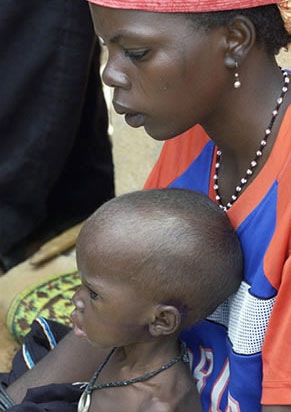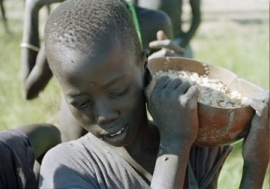Niger: a famine foretold
Niger: a famine foretold
The seasonal rains returned to southern Niger in June, coaxing the green millet stalks from the dry earth and signalling an end, hopefully, to a food shortage that has left some 2.4 million Nigeriens — including 800,000 children — vulnerable to malnutrition. International relief workers have also started to arrive to distribute the emergency rations needed until the harvest is in.
But neither the millet nor the aid came soon enough for Fassoma Abdoulsalam. The one-year-old died on 10 August, one of some two dozen children to succumb to malnutrition in the village of Birgi Dangotcho in the hard-hit Zinder region.
It was not an uncommon tragedy in a country where malnutrition, child mortality and poverty rates are high even in good times. What distinguished her death was that the world knew it was coming almost from the moment of her birth, yet failed to prevent it.

‘Deafening silence’
Experts place part of the problem with the localized nature of the food shortages, which drove up regional food prices and led the government, the UN and relief groups to view the situation as one of chronic poverty and distorted grain markets instead of as an emergency. The non-governmental Médecins sans frontières (MSF) criticized the UN for coming too late, with too little, and for failing to sound the alarm soon enough.
But in fact, the UN and other monitors began reporting that southern Niger was slipping into crisis as early as November 2004, following a poor harvest due to drought and locusts. The following month the government of Niger issued an emergency appeal for over 78,000 metric tonnes of food aid, with the support of the UN World Food Programme (WFP). That appeal, and the ones that followed, noted the head of UN humanitarian operations, Under-Secretary General Jan Egeland, were met by a “near-deafening silence.”
The efforts of the UN and other relief groups to alert the world to Niger’s impending crisis were numerous (see chronology below).
But only in mid-July, after the UK’s BBC broadcast images provided by the UN of dying Nigerien children, did donors finally begin responding. WFP received more pledges in the 10 days following the broadcast than it had in the eight previous months. “The fact that the world can be moved only by the images of graphic suffering is nothing to celebrate,” lamented WFP Executive Director James Morris. “Many of the children who featured in the news reports are already beyond help.”
Fixing an ‘irrational’ system
In the view of many observers, the preventable deaths and suffering in Niger underscore the need for fundamental reform of the headline-driven global emergency response system — a system MSF Executive Director Nicolas de Torrente recently denounced as “completely irrational.” Most proposals call for an emergency fund large enough to permit immediate responses to humanitarian situations before they become crises. Currently, the WFP and other agencies may borrow only limited funds from the UN emergency fund or other operations for rapid responses — and then only if they have received donor pledges of repayment.
“Imagine if your local fire department had to petition the mayor for money every time it needed water to douse a raging fire,” Mr. Egeland remarked. “That’s the predicament faced by anguished humanitarian aid workers when they seek to save lives but have no funds to pay for the water — or medicine, shelter or food — needed to put out a fire.… These delays are deadly.”
To speed lifesaving responses, Mr. Annan has proposed a tenfold increase, to $500 mn, in the UN emergency fund. He has also called for greater international efforts to combat the long-term causes of hunger. With over 4 million people in Africa’s Sahel region in need of food aid and over 10 million people now at risk in Southern Africa, the needs of the hungry cannot wait.
Numerous alarms over Niger’s developing famine
December 2004:
The U.S.-based Famine Early Warning System declares that Niger requires “urgent attention.” A UN assessment reports 3 million people at risk.
January 2005:
WFP reports in detail on Niger’s food requirements.
February 2005:
WFP launches an emergency feeding programme for 400,000 people.
March 2005:
UN and government agencies in Niger appeal for $7 mn at a donor’s conference.
May 2005:
With government and WFP food stocks dwindling, the UN issues a “flash” emergency appeal for $16.1 mn. But only Luxembourg pledges $320,000. Mr. Egeland warns that 150,000 children face imminent death.
June 2005:
The WFP describes the situation in Niger as “very dire.” WFP Executive Director James Morris reports to the UN Security Council that only 11 per cent of required funding has been received.
July 2005:
UN agencies issue a new appeal for $30 mn in emergency aid for 1.2 million Nigeriens, but initial pledges reach only $10 mn. UN Secretary-General Kofi Annan visits Niger to highlight the need for urgent action.












